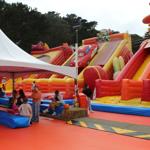The main difference between the public school Peninsula Athletic League and its private school counterparts when it comes to planning for high school athletics is the private school leagues span two or more counties.
The West Bay Athletic and Private School Athletic leagues are comprised of schools from San Mateo and Santa Clara counties. The West Catholic Athletic League has schools in those two counties, while adding a third with three schools in San Francisco County.
All of which create hurdles in putting together sport schedules. The simple rule is: schools and teams in adjoining counties can play each other, but a team can’t jump a county to play another school.
The WCAL is the only league that has schools in three counties — San Francisco, San Mateo and Santa Clara counties. Teams in San Mateo County can play against teams in both San Francisco and Santa Clara counties. But Mitty, a Santa Clara County school, could not play St. Ignatius, a San Francisco County school.
But like everyone and everything else, those leagues are adapting. Jolene Fugate, WCAL commissioner, said her league will be split into North and South divisions — St. Francis, Mitty, Valley Christian and Bellarmine/Presentation in the South, and Serra joining San Francisco schools Riordan, Sacred Heart Cathedral and St. Ignatius to form the North division.
Scheduling challenges
Fugate, however, is keeping a “normal” schedule in her back pocket, just in case.
“I’m creating a North-South schedule and a single round-robin schedule,” Fugate said. “We’re hopeful some county restrictions may change [as spring approaches].”
Schools in the PSAL and WBAL are still planning on implementing their standard divisional league formats but, like everything else, that could change. Mark Bermudez, athletic director at Pacific Bay Christian in Pacifica who also sits on the CCS board of managers, said the PSAL has a bit of advantage as it has divided its 23-school league into two divisions, based on geography.
Frank Rodriguez, Sacred Heart Prep AD and a member of the CCS executive committee, said the 12-team WBAL, on the other, is maintaining its traditional competitive equity-based divisional system.
“There hasn’t been any discussion about tossing those divisions as of yet,” Rodriguez said.
The private school leagues also differ from their public school counterparts in what sports will be offered. The guidelines put in place by the state do not necessarily align with the California Interscholastic Federation’s “Season 1” and “Season 2” sports delineation. So while the PAL is trying to get a cross country, swimming, and girls’ golf and tennis seasons going, the WCAL, WBAL and PSAL are only currently concerned with getting a cross country season up and running.
With the PAL having girls’ golf and tennis, and swimming competing now, those sports would not be eligible for any kind of CCS or CIF postseason.
Cross country is currently the only Season 1 sport that is allowed to compete at this time and all the local leagues — public and private — are planning on league competitions. The CIF already declared that there would be no state meet for Season 1 sports this year.
The WCAL and WBAL are keeping the other sports in their Season 2 designation and the PSAL does not compete in golf or tennis.
While the leagues have preliminary cross country schedules set, there are still logistical challenges.
“Trying to figure out venues (to host cross country races) is the biggest challenge,” Rodriguez said. “It would be wonderful to have some kind of league meet. … But I’m not sure how realistic that is. We’re still trying to figure out if we can do something.”
Recommended for you
Fugate said the biggest hurdle in that regard is that any time more than two teams — or cohorts — are involved, schools need county permission to hold such an event.
Because the private schools are only concentrating on getting a cross country season together, it has allowed them to put more of a focus on Season 2 sports, which is presenting its own challenges.
Size can be an issue
While the WBAL and PSAL may have a range of schools, many of them are very small and depend on the same athletes to participate in several sports. With the state not allowing athletes to participate in more than one cohort, athletes at many of the smallest schools may have decide between playing one sport over another, which could affect the school’s ability to field a team in any specific sport. That means league officials have to wait to find out which schools and teams are in or out.
“Right now … we need to wait and find out and see which schools will field a team in [some] sports,” Bermudez said. “Right now, we have a league schedule and we’ll make adjustments as needed.”
The WCAL is experiencing a different problem regarding size. While the student populations at most of the WCAL schools exceed those in other leagues, having only eight schools presents a problem of scheduling. Fugate said the league has left open the possibility of playing non-league games, because as things currently stand, Serra, for instance, would be limited to six league games if it played only the San Francisco schools twice.
The thought is to bulk up the schedule by playing non-league games in adjacent counties — but there is no guarantee of that happening.
“We’re limiting league play and then give schools more flexibility. To give them an opportunity to play (non-league games),” Fugate said. “The reality is, there may not other schools available.”
In that case, Fugate said another round of division play would be added to the schedule.
Getting close
Despite the issues that still need to be worked out after 11 months of the pandemic, high school sports administrators are starting to see some light at the end of the tunnel.
“Absolutely,” said Justin Ferdinand, Serra AD. “From Day 1, this has been about giving the kids an opportunity and an experience. As we progress through the next few weeks, the hope is everything will expand and we can have more conversations about more sports (starting play).”
And while cross country races begin to take shape, athletes at Notre Dame-Belmont already have one competition under its belt. Jason Levine, NDB AD, said his school’s “pom team,” a division of cheerleading, has already competed in a virtual event. Since the sport is not recognized by CIF, schools are allowed to compete in any of the various national organizations supporting high school cheerleading.
Levine said the pom team can compete because of the social distancing nature of the activity.
“They’ve been practicing all year. We’ve been allowing the team to practice in the gym. It’s only eight girls and they practice with masks,” Levine said. “We did three run-throughs, filmed each of them and then selected the best version and we submitted that and judges will score that.
“It was exciting because it was our first competition.”






























(0) comments
Welcome to the discussion.
Log In
Keep the discussion civilized. Absolutely NO personal attacks or insults directed toward writers, nor others who make comments.
Keep it clean. Please avoid obscene, vulgar, lewd, racist or sexually-oriented language.
Don't threaten. Threats of harming another person will not be tolerated.
Be truthful. Don't knowingly lie about anyone or anything.
Be proactive. Use the 'Report' link on each comment to let us know of abusive posts.
PLEASE TURN OFF YOUR CAPS LOCK.
Anyone violating these rules will be issued a warning. After the warning, comment privileges can be revoked.